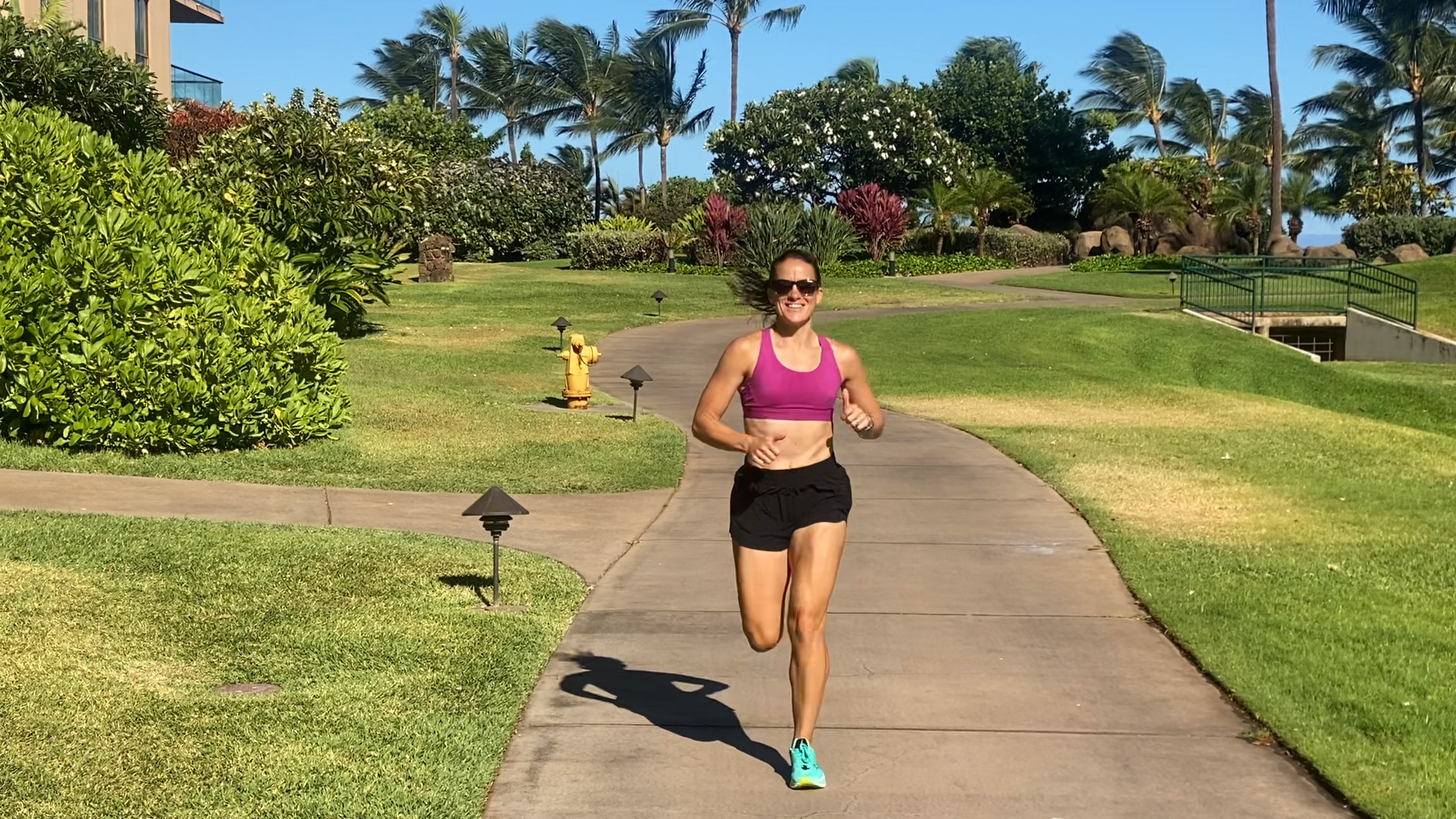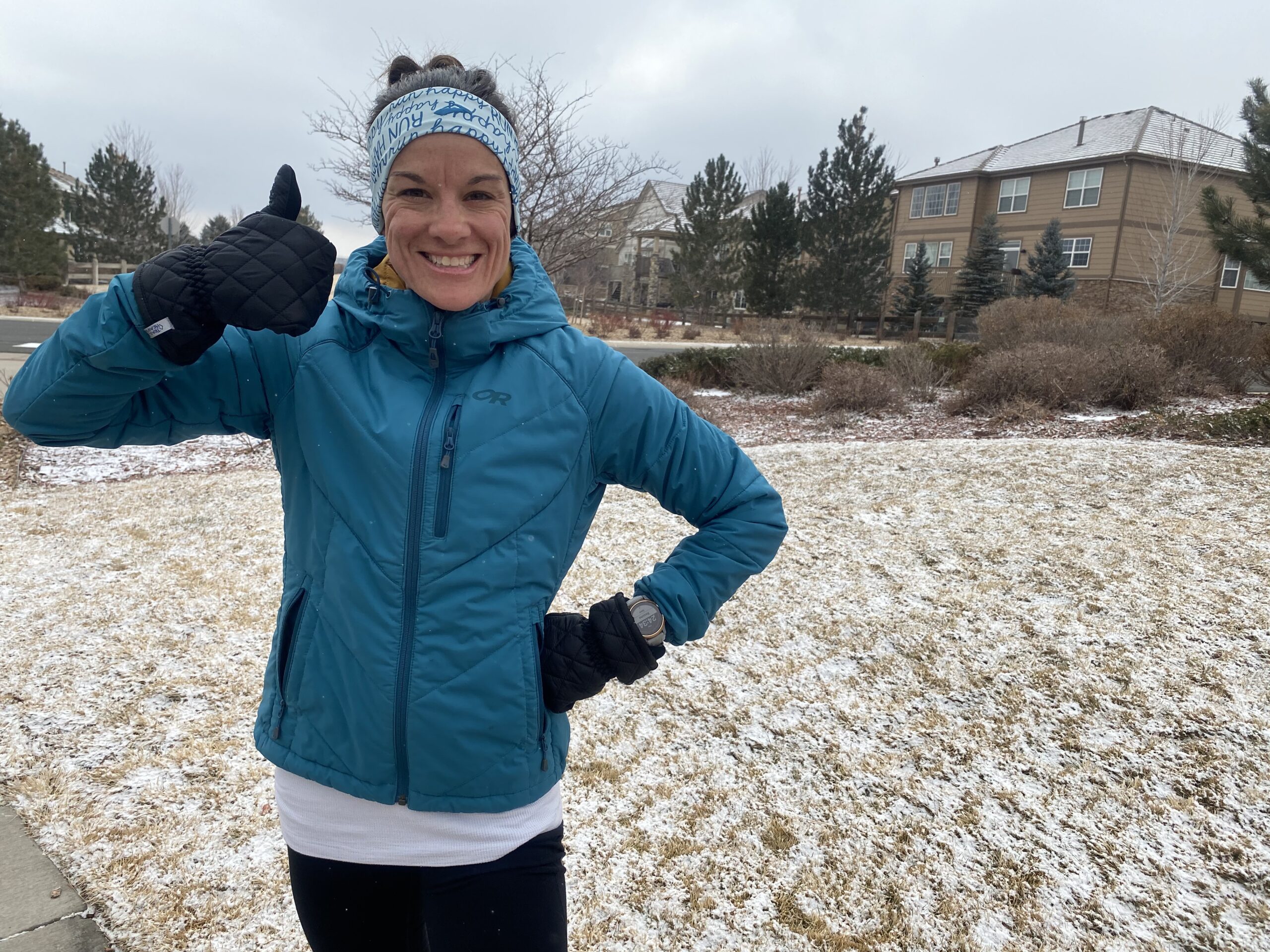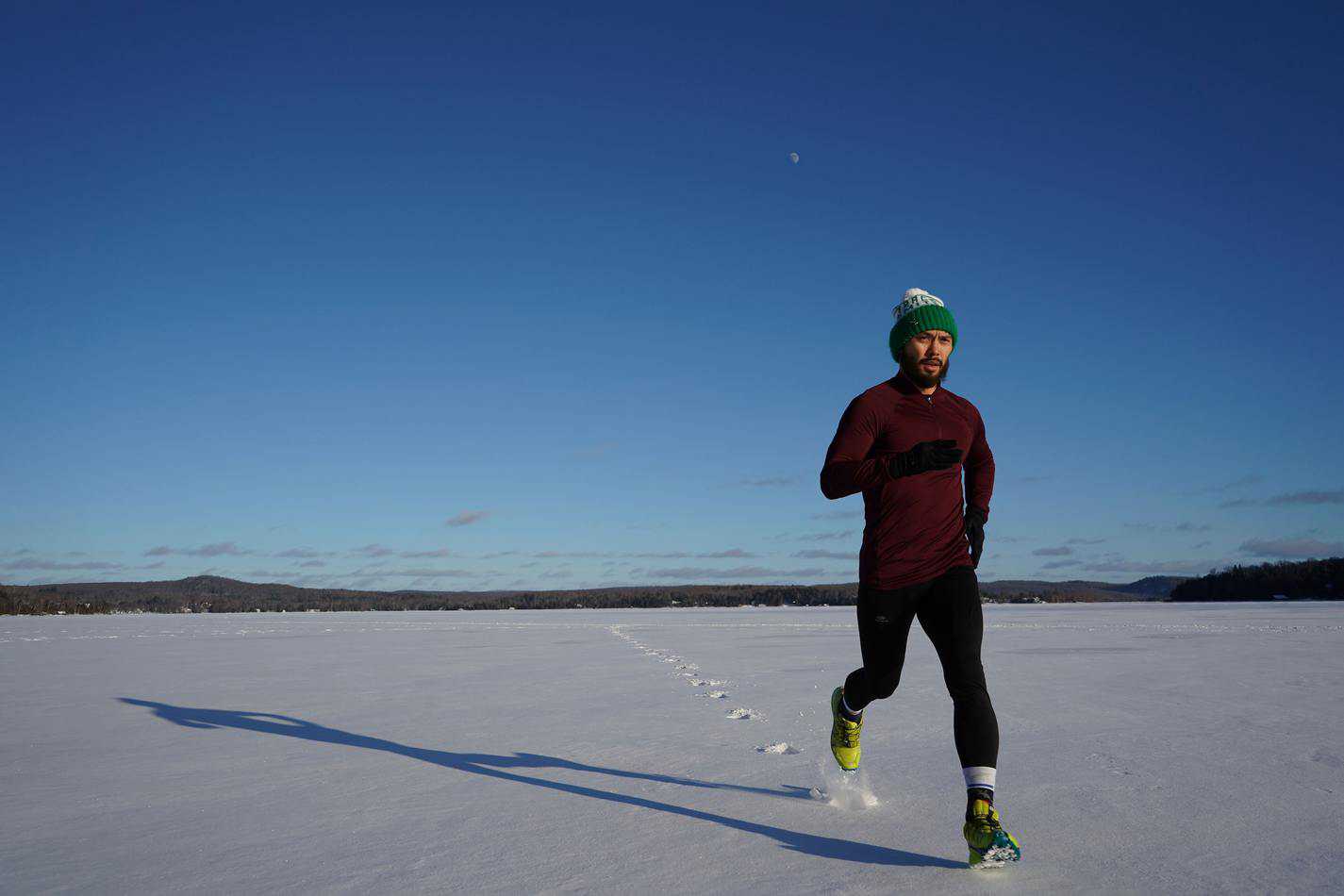You’re signed up for a fall marathon and are excited to start your training. Except…it’s so hot outside, and suddenly, running feels really slow and uncomfortable.
The biggest concern and consideration for most runners training for a marathon over the summer months is the heat. Heat stress and dehydration can and do impair performance, according to the British Journal of Sports Medicine. And there’s no question that heat is a significant factor that can affect your training.
Even though it’s hot out, you CAN still enjoy marathon training! By following our tips, you’re likely to have a great summer training cycle leading up to your fall marathon.
How Do I Train for a Marathon in the Summer?
The “how” of training for a marathon in summertime isn’t going to vary much from how you would train for a marathon at any other time of year.
You’ll have a weekly long run, of course; 3-5 additional weekly runs for speed, mileage-building, or recovery (yes running can be recovery – more here) purposes; you’ll strength train and do mobility work; and you’ll take fuel and hydration along with you for mid-run energy and as practice for race day.
RELATED: Marathon Nutrition: How to Fuel Your Best for Race Day
The summer heat can and will affect other aspects of your training, such as when and where you train, and what paces you’re running at, especially compared to cooler months of the year.
Minimizing the Effects of the Heat
According to the British Journal of Sports Medicine, there are three key ways in which to minimize the effects of the heat while you train: acclimate, hydrate and keep cool.
Acclimate
Your body needs to acclimate to the new temperatures it will be running in. Heat acclimatization is the best way to reduce physiological strain and optimize performance when exercising in the heat.
So how, exactly, do you do that acclimate to the heat?
Scientists suggest that it takes 1-2 weeks of repeated heat exposure before your body is acclimated and you aren’t as bothered by the heat as you were initially.
Start with shorter runs in the warmer weather and then gradually increase your time and intensity. This will allow your body to adapt.
It’s as simple as continuing to run in the heat, and soon you’ll find that the warmer temperatures aren’t nearly as noticeable or affect you as much.
Hydrate
Being well-hydrated can minimize the effects of heat on your body. You should be drinking plenty of fluids before, during, and after your training runs. Take that water with you even on a short run! (More on taking electrolytes along with that hydrate as you read.)
Keep Cool
Using proven methods to keep yourself cool can help minimize heat discomfort and the health risks associated with heat stress.
Ice packs, cold vests, wet towels, and cold water immersion are some techniques that scientists say are proven for cooling your core body temperature quickly.
We’ll discuss other ideas for keeping your body cool when training in the heat, such as dressing appropriately and avoiding direct sunlight, in more depth later in this article.
Top Tips for High-Quality Marathon Training in the Summer Months
Now that we’ve addressed general principles of staying comfortable and safe while training in warm weather, let’s turn to specific tips to get the most out of your summer marathon training runs!
Hydrate to Train Well
On average, a runner can lose between 1.5-2.5 liters of sweat per hour of exercise on hot and humid days. This can equate to approximately 2-4% of an average person’s body weight! It’s important to ensure that water and sodium losses are replenished, according to scientists.
Being well-hydrated for your training runs is crucial to your success on the run, and to your overall health.
How Much, and When, Should I Drink?
When it’s hot outside, carry water or a sports/electrolyte drink with you during all of your warm weather runs.
Plan to drink early and often. Sports dietitian and experienced marathoner Jen Scott recommends that runners drink approximately 8 ounces of fluids in the 30 minutes before starting a run. She then recommends that runners consume 3-6 ounces of fluid every 15 minutes during the run. Afterwards, runners should drink 16 ounces for every pound of weight lost during the run in order to replenish stores.
You can also boost your hydration by avoiding or reducing soda and alcohol consumption in the hours and days leading up to your run.
The Importance of Electrolytes
Electrolytes are essential minerals that your body needs to perform its various functions. Sodium is one of the most important electrolytes for your body. Sodium is crucial to prevent hyponatremia, a potentially deadly disruption of the fluid and electrolyte balance in your body that can be caused by too much plain water, heavy sweat losses, and inadequate sodium intake or repletion.
According to Scott, runners should consume 200-700 mg of sodium per hour of exercise (for reference, 1/4 teaspoon of salt contains 575 mg of sodium). Sports and electrolyte beverages, salt tabs, or electrolyte tabs/chews consumed on your training runs can help replace liquid losses, keep you better hydrated, and help prevent hyponatremia. A few of our favorite products to ensure you’re getting enough sodium include Saltstick chews, LMNT and Skratch Labs High Sodium Hydration for the warmest days.
Adjust Your Pace Expectations
Let’s face it – it’s really hard to hit faster running paces in the heat and high humidity! But you’re in luck, because slowing down during your runs is actually a good thing.
How can slowing down benefit you later on? By running slowly, you are building up and strengthening your aerobic system, which over time, will make you a faster runner!
RELATED: Train Slower to Run a Faster Marathon
If you’re starting to get down on yourself for running slower than normal during summer, remember: slowing down benefits you (and newsflash – this is happening to every runner, not just you!)
Come race day in the fall, your body will be primed and ready to perform in top shape.
Beat the Heat
No matter how acclimated you are to training in heat, you still want to make your training runs as comfortable as possible by avoiding direct sunlight.
One way to avoid direct sunlight is by running at the coolest times of day. For many people, this means running when the sun is low in the sky (or when it’s dark out)!
Runners who ordinarily train midday might want to adjust their summer training times to early mornings or late evenings. If this applies to you, play around with what works best for you and your lifestyle.
Another way to avoid direct sunlight is to seek shady running routes. For instance, in warmer months, I prioritize running my long runs at a shady trail that is a bit farther away from home. To me, it’s worth the extra drive to run on a trail where large, mature trees line nearly the entire path. It makes summertime long runs much more enjoyable!
Make Summer Marathon Training Fun!
Summer marathon training doesn’t have to feel like one long, hot slog to your fall marathon. Find ways to incorporate warm-weather fun into your training runs!
Maybe it’s jumping into a pool for a quick swim at the end of your sweaty runs. Perhaps you have a weekly water fight with your kids to celebrate another long run checked off your plan. Or maybe it’s seeking out sprinklers and running through them mid-run as much as you can every week (ask me how I know about this!).
Regardless of what you choose, make time to incorporate fun summertime activities: you’ll stay cool and enjoy the training process much more.
Recommended Gear for Summer Marathon Training
In summer, always aim to wear lightweight, breathable and lighter-colored clothing for maximum sweat-wicking and cooling properties. Be sure to choose pieces made from technical fabrics. (Fabrics such as cotton can weigh you down as they get sweaty, and cause discomfort and painful chafing.)
We have rounded up our personal favorite gear for summer marathon training below. We hope you find these products as helpful as we have!
For a successful summer training cycle, we recommend:
- Sunscreen – Check out our favorite tried-and-tested sunscreens for running here. (La-Roche Posay Dry-Touch is the absolute best for the face!)
- Sunglasses – We love Tifosi and Knockaround brand sunglasses!
- Hats/Headbands – We recommend our favorites here, including the Sweat GUTR that will keep the sweat from dripping in your eyes
- Water Bottles and Packs – Nathan makes a ton of reliable, quality products to carry your water and other items. For your longest runs we highly recommend getting a vest that carries a minimum of 40 ounces of water, such as the Nathan Pinnacle.
- Anti-chafe products – Body Glide helps prevent painful chafed skin – and honestly just Aquaphor is one of the best you can find for this, too.
- Socks – Avoid dreaded blisters with our favorite socks, here.
- Shorts with pockets – POCKETS, need I say more? Here are our faves for women, and for men I highly recommend the Lululemon Pacebreaker.
Having the right hydration, fueling and gear is all key for making sure a warm run not go sideways. But sometimes it’s not safe to continue or to go out in the conditions at all. So how do you know when hot is too hot?
Is It Safe to Train for a Marathon When It’s Hot?
Number ONE we want to make sure you’re staying safe through your warm, summer training. Here’s what you need to know.
It is generally safe to train for a marathon when it’s hot outside, as long as you take proper precautions. The methods described above – acclimate, hydrate and keep cool – are important keys to your overall safety and well-being while training in warmer months.
For your safety, you also need to know the warning signs of heat-related illness, in case of emergency.
Know the Warning Signs
Every year, approximately 9,235 people are hospitalized due to the effects of the heat, according to the U.S. Centers for Disease Control. The good news is that heat-related illnesses are 100% preventable.
Athletes (including runners!) are among the most vulnerable populations to heat illness. You should know the warning signs and symptoms of heat exhaustion and heat stroke, and monitor them through your run.
If (or when) you recognize the signs and symptoms of heat-related illness in yourself or your training partner(s), take immediate action. Stop running and get to a cooler location as quickly as you can.
Heat Exhaustion
Heat exhaustion is a type of heat-related illness. It is serious and should be addressed immediately. According to the CDC, the symptoms of heat exhaustion include:
- Heavy sweating
- Cold, pale and clammy skin
- Fast, weak pulse
- Nausea or vomiting
- Muscle cramps
- Tiredness or weakness
- Dizziness
- Headache
- Fainting
If you experience these symptoms, move to a cool place. Cool your body by loosening your clothing and applying cool, wet cloths to your skin. You may take sips of water, too.
Seek medical attention if you are throwing up, your symptoms worsen, or your symptoms last longer than 1 hour.
Heat Stroke
Heat stroke is the most severe – and dangerous – form of heat-related illness. It is a medical emergency, and if someone is experiencing these symptoms, 911 should be called immediately:
- High body temperature (103 degrees F or more)
- Hot, red, dry or damp skin
- Fast, strong pulse
- Headache
- Dizziness
- Nausea
- Confusion
- Losing consciousness (passing out)
It is important to monitor how you’re feeling over the course of a run and cut it short if you have any of the early warning signs so that it doesn’t get to a severe point.
Should I Avoid Hot Weather During Summer Marathon Training?
After reading the warning signs, it can make you think you should probably just avoid the heat completely and only go running early or late when it’s cooler or just inside and use the treadmill. And that’s absolutely true if the conditions suggest it’s dangerous to run outside, such as the heat chart from this article indicates, or you know you’re going to be out for a long time.
However, there are benefits to running in the heat, as well, so we don’t suggest just avoiding it altogether.
Some of the benefits of running in the heat, also referred to as the “poor man’s altitude training” haha, include:
- Increased cardiovascular fitness: Running in the heat forces your cardiovascular system to work harder. With regular exposure, this can lead to improved cardiovascular fitness, enhanced endurance, and increased lung capacity.
- Improved calorie burn: Exercising in the heat often increases the intensity of your run. When your body has to work harder to cool itself down, it can result in a higher calorie burn compared to running in cooler conditions.
- Adaptation to heat stress: Regular exposure to heat during workouts can help your body adapt and become more efficient at dissipating heat. This adaptation process, known as heat acclimation, can improve your performance in hot conditions and reduce the risk of heat-related illnesses.
- Increase of blood plasma volume: This allows for better ability to transport oxygen and nutrients to the working muscles which promotes cardiovascular performance and the ability to sustain exercise for longer periods and better thermoregulation (aka cooling you down more efficiently).
And let’s not forget that you never know what kind of weather you’ll get on race day! So practicing in less than ideal weather, heat or otherwise, will prepare you to push through whatever may come your way. Bottom line, make sure you’re staying safe, but marathon training in the summer can most often be done when being prepared AND it will help you become a more well-trained runner in the process.







